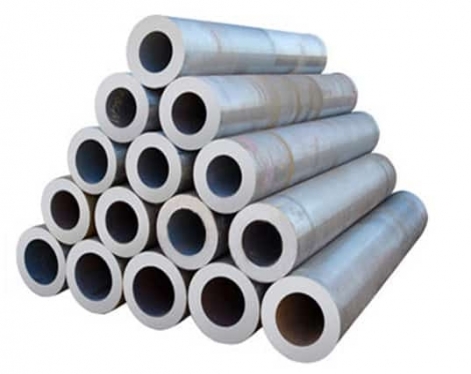The high temperature resistance test of seamless steel pipe is designed to uate its ability to maintain mechanical properties and resist various high temperature damage in high temperature environment. These tests are essential to ensure the safety and reliability of seamless steel pipe in high temperature applications. Nansteel Manufacturing Co., Ltd carefully summarizes the following 8 commonly used high temperature resistance test methods for seamless steel pipe:
1. High temperature tensile test
Purpose: To determine the mechanical properties of steel pipes such as tensile strength, yield strength, elongation and area reduction at different high temperatures.
Method: The steel pipe sample is heated to a predetermined high temperature, and a tensile test is carried out at this temperature. The test data is recorded and the stress-strain curve is plotted. By comparing the mechanical properties data at different temperatures, the high-temperature strength and plasticity of the steel pipe are uated.
Standard: Commonly used standards include GB/T 228 "Metallic Materials Tensile Test Part 1: Room Temperature Test Method", GB/T 2039 "Metal High Temperature Tensile Test Method", ASTM E21 "High Temperature Tensile Test Method", etc.
2. Endurance strength test (creep test)
Purpose: To determine the time required for creep deformation or fracture of steel pipes under constant high temperature and constant tensile stress. Creep refers to the slow plastic deformation of metal materials at high temperature under constant stress.
Method: Heat the steel pipe sample to a predetermined high temperature and apply a constant tensile stress for a long time. Record the deformation and fracture time of the sample. Draw a creep curve based on the test data to uate the creep resistance of the steel pipe.
Standards: Commonly used standards include GB/T 2087 "Metallic Materials - Creep and Endurance Test Methods", ISO 204 "Metallic Materials - Uniaxial Creep Test Methods", ASTM E139 "Standard Test Methods for Creep, Creep-Rupture and Stress Relaxation Tests on Metallic Materials", etc.
Importance: For seamless steel pipes working in high temperature environment for a long time, such as boiler pipes, pressure vessel pipes, etc., creep performance is a very important indicator.
3. High temperature endurance performance test
Purpose: To determine the time required for a steel pipe to rupture under constant high temperature and constant internal pressure.
Method: Conduct an internal pressure test on the pipe and record the rupture time of the sample under the test temperature and internal pressure conditions.
Scope of application: This method is mainly used to uate the long-term performance of pipelines under high temperature and high pressure, such as high-temperature pipelines in petrochemical, power and other industries.

4. Antioxidant performance test
Purpose: To determine the ability of steel pipes to resist oxidation in high temperature air or other oxidizing media.
Method: Heat the steel pipe sample to a predetermined high temperature and expose it to air or other oxidizing media at this temperature for a certain period of time. Then measure the weight change of the sample, the thickness of the surface oxide layer and other indicators to uate the oxidation resistance of the steel pipe.
Standard: Commonly used standards include GB/T 17791 "High Temperature Oxidation Test Methods for Metallic Materials", ISO 10269 "Metallic Materials. High Temperature Oxidation Test", etc.
5. Thermal shock test
Purpose: To uate the ability of steel pipes to resist thermal stress damage under conditions of rapid temperature changes.
Method: The steel pipe sample is subjected to a rapid heating and cooling cycle, and the surface defects such as cracks and deformation are observed to uate the thermal shock resistance of the steel pipe.
Scope of application: This method is suitable for occasions where the working temperature changes drastically, such as some metallurgical equipment, heat treatment equipment, etc.
6. Metallographic inspection
Purpose: To observe the changes in the metallographic structure of steel pipes after exposure to high temperatures, such as grain growth, carbide precipitation, etc., and to uate the effect of high temperature on the microstructure of steel pipes.
Method: After the steel pipe sample was metallographically prepared, its structure was observed through a metallographic microscope.
7. Chemical composition analysis
Purpose: To determine whether the chemical composition of the steel pipe meets the standard requirements. Different alloy elements have different effects on the high temperature performance of steel.
Method: The content of each element in the steel pipe is determined by spectral analysis, chemical analysis and other methods.
8. Other tests
According to the specific application requirements, some other high temperature performance tests can also be carried out, such as high temperature fatigue test, high temperature corrosion test, etc.
Read more: Key Points of Machining Cold Drawn Seamless Pipes
1. High temperature tensile test
Purpose: To determine the mechanical properties of steel pipes such as tensile strength, yield strength, elongation and area reduction at different high temperatures.
Method: The steel pipe sample is heated to a predetermined high temperature, and a tensile test is carried out at this temperature. The test data is recorded and the stress-strain curve is plotted. By comparing the mechanical properties data at different temperatures, the high-temperature strength and plasticity of the steel pipe are uated.
Standard: Commonly used standards include GB/T 228 "Metallic Materials Tensile Test Part 1: Room Temperature Test Method", GB/T 2039 "Metal High Temperature Tensile Test Method", ASTM E21 "High Temperature Tensile Test Method", etc.
2. Endurance strength test (creep test)
Purpose: To determine the time required for creep deformation or fracture of steel pipes under constant high temperature and constant tensile stress. Creep refers to the slow plastic deformation of metal materials at high temperature under constant stress.
Method: Heat the steel pipe sample to a predetermined high temperature and apply a constant tensile stress for a long time. Record the deformation and fracture time of the sample. Draw a creep curve based on the test data to uate the creep resistance of the steel pipe.
Standards: Commonly used standards include GB/T 2087 "Metallic Materials - Creep and Endurance Test Methods", ISO 204 "Metallic Materials - Uniaxial Creep Test Methods", ASTM E139 "Standard Test Methods for Creep, Creep-Rupture and Stress Relaxation Tests on Metallic Materials", etc.
Importance: For seamless steel pipes working in high temperature environment for a long time, such as boiler pipes, pressure vessel pipes, etc., creep performance is a very important indicator.
3. High temperature endurance performance test
Purpose: To determine the time required for a steel pipe to rupture under constant high temperature and constant internal pressure.
Method: Conduct an internal pressure test on the pipe and record the rupture time of the sample under the test temperature and internal pressure conditions.
Scope of application: This method is mainly used to uate the long-term performance of pipelines under high temperature and high pressure, such as high-temperature pipelines in petrochemical, power and other industries.

4. Antioxidant performance test
Purpose: To determine the ability of steel pipes to resist oxidation in high temperature air or other oxidizing media.
Method: Heat the steel pipe sample to a predetermined high temperature and expose it to air or other oxidizing media at this temperature for a certain period of time. Then measure the weight change of the sample, the thickness of the surface oxide layer and other indicators to uate the oxidation resistance of the steel pipe.
Standard: Commonly used standards include GB/T 17791 "High Temperature Oxidation Test Methods for Metallic Materials", ISO 10269 "Metallic Materials. High Temperature Oxidation Test", etc.
5. Thermal shock test
Purpose: To uate the ability of steel pipes to resist thermal stress damage under conditions of rapid temperature changes.
Method: The steel pipe sample is subjected to a rapid heating and cooling cycle, and the surface defects such as cracks and deformation are observed to uate the thermal shock resistance of the steel pipe.
Scope of application: This method is suitable for occasions where the working temperature changes drastically, such as some metallurgical equipment, heat treatment equipment, etc.
6. Metallographic inspection
Purpose: To observe the changes in the metallographic structure of steel pipes after exposure to high temperatures, such as grain growth, carbide precipitation, etc., and to uate the effect of high temperature on the microstructure of steel pipes.
Method: After the steel pipe sample was metallographically prepared, its structure was observed through a metallographic microscope.
7. Chemical composition analysis
Purpose: To determine whether the chemical composition of the steel pipe meets the standard requirements. Different alloy elements have different effects on the high temperature performance of steel.
Method: The content of each element in the steel pipe is determined by spectral analysis, chemical analysis and other methods.
8. Other tests
According to the specific application requirements, some other high temperature performance tests can also be carried out, such as high temperature fatigue test, high temperature corrosion test, etc.
Read more: Key Points of Machining Cold Drawn Seamless Pipes









